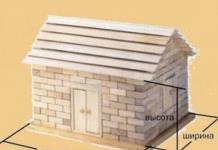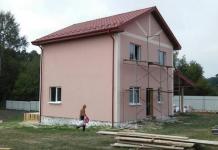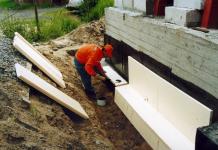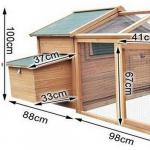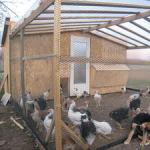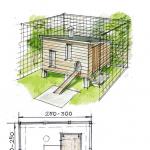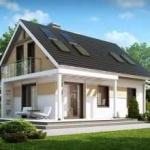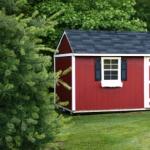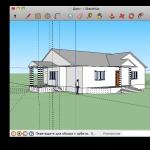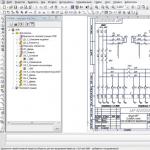In recent years, the proportion of frame houses developed using Canadian technology has increased in Russian construction. Subsequently, they were improved by masters from Germany, Finland, Sweden, who made various additions, based on the climate conditions in a particular country.
Canadian frame houses are built in the form of a layered pie. First, a frame is made of timber, and then special panels are fixed on this structure, which consist of several layers. Insulating material is placed between two layers made of chipboard.

Siding, lining or false beams are then sewn onto the panels, putting a special film under them, thanks to which the building is protected from the negative effects of the environment and temperature changes.
Benefits of Canadian Technology Solutions
Canadian technology houses are usually chosen by middle-class people. What are the advantages of this type of construction?
- Buildings are being built at cost-effective prices. Each of the frame-based buildings costs half as much as the brick version.
- The building is erected quickly in comparison with other technological solutions.
- The presence of warmth and good atmosphere in the house.
- Saves energy costs.
- Maintenance of the building is cheaper compared to stone houses.
- Ease of repair work.
- There is no need to install a heavy and expensive foundation.
- Possibility of a large choice. The house can be built according to a standard design and economy class style.
- Originality of architectural solutions.
- Construction can be carried out on any site.
- Communication is easy to do.
- If necessary, a building created using Canadian technology can also be quickly dismantled and installed in a new location. What is a clear advantage of such frame structures.
Negative points
Building houses using Canadian technology, unfortunately, has some negative sides. If the structure is assembled incorrectly, then high heat losses can be encountered. But the house should be provided with ventilation so that the heat-insulating layers do not rot.
Attention should be paid to the choice of material when assembling the structure. The raw material must be dry. If this is ignored, mold and cracks may appear, as a result of which the structure may completely collapse.
Frame houses have low sound insulation than buildings with denser materials. But if, during assembly, an additional layer of material is installed that prevents the appearance of sound and noise, then this negative moment is completely eliminated.
Stages of building houses based on Canadian technologies
Before the start of construction, you can view photos of houses, the construction of which is carried out using various technologies, including Canadian ones.
Having decided on the design of the future building, it is necessary to develop a project. You can draw it yourself or ask for help from people knowledgeable in this area. Having received the project of a Canadian house, you should purchase all the building materials necessary for the construction.
After clearing the area allotted for construction from various debris, grass and bushes, you should take up the base site, which will serve as the basis for the rest of the structure. The foundation and the floor act as the base platform.
Initially, it is necessary to carry out the arrangement of the draft version of the floor. The design is made from the cheapest materials, which are unedged boards. You need to know that the walls and floors in Canadian-style houses are made from the same type of wood.
For the stability and reliability of the frame structure, special reinforcement is laid during the construction and a concrete foundation is poured. A few weeks after pouring the foundation, it is necessary to lay boards that will help indicate the location of the walls and rooms in the future structure.
To prevent rotting, wood should be treated with antiseptic agents. Between the foundation and the boards should put a layer of roofing material and insulation. The boards are reinforced with special anchor bolts.
After the floor is made, you can begin to build walls, checking their evenness with a level. If this is not observed, then there may be a distortion of the structure in the future.
First, a lower trim is constructed in the form of a beam, which has special grooves. Measure and saw off vertical boards about 2.7 meters high. Then steel pins are inserted into the locations of the racks. Assemble the frame from the corner. The bars are inserted into the pins, and then fixed with temporary jibs. Similarly, the installation of intermediate bars is carried out.
At the next stage, the upper strapping is carried out. This requires the use of similar bars with grooves, which are used in the process of lower strapping. Fixation of the upper strapping is carried out with nails.
After the frame is made, the temporary jibs are dismantled and replaced with permanent ones. This will help to give the structure additional strength and partially relieve the load.
Then carry out the fastening of the ceiling beams. They are made of bars measuring 5 by 15 cm. There should be a half-meter distance between the beams. It should be ensured that the beams and racks placed vertically do not match. A timber should be installed in the house as a support in place of the partition between the rooms.
Rafters are installed on top of the frame. Their role is played by boards with a thickness of 5 cm and a width of 10 cm. Then the crate should be laid at an angle of 45-50 degrees.
The rafters are fastened with 15 cm nails. To make the structure strong, the ridge board is stuffed onto the central rafters. At the next stage, the crate is performed, followed by the laying of roofing material on it. Then roofing material in the form of slate or tile should be laid on its surface. Slate nails help in fastening.
In the future, it is worth doing the outer wall cladding. Initially, boards are taken and cut, depending on the size of the frame. Later, the back wall is sheathed.
Fastening the first board start from the bottom. A board is attached to each of the racks with 5 cm nails. It is worth making sure that the joints and grooves are fitted tightly. After the entire frame is sheathed, it is worth using a sealant to protect it from the negative effects of the environment.
With strict observance at each stage of all precautions, a quickly high-quality house is obtained. It can be built independently or with the help of professionals. In any case, it is worth reviewing all the pros and cons of designs in order to avoid unpleasant moments in the future.

































Due to the speed of construction, country houses based on Canadian technology are widely in demand on the country real estate market, especially since they are easy to order on a turnkey basis. This construction method is very common in Canada, which gave the houses built using this technology their name. Well, since the climatic conditions of Canada are close to domestic ones, the methods developed and tested in this country for the construction of suburban housing are relevant for Russian buyers. What can Canadian technology houses look like: projects, prices, photos in our article.

A small frame house built using Canadian technology Source karkas-nsk.ru
Canadian houses: a bit of history
The first frame buildings were known in Europe during the early Middle Ages. In those days, the structure was based on a system of posts and beams with braces arranged diagonally. The space between the parts of this frame structure was filled with stone, bricks or clay.
The colonists who came to Canada and the United States from Europe used this technology, which allows them to create houses at any time of the year in a short time. To protect against the harsh weather conditions of Canada, the walls of the houses were sheathed with boards on the outside and inside, and the voids were filled with any available material. Most often, a mixture of clay, straw, sand and stone was used.

Houses in old European cities are "distant ancestors" of modern frame technology Source nkkconsult.ru
Thus, the basis for the creation of houses using Canadian technology already in those days was the prototype of insulated panels, with the help of which it was possible to build a high-quality warm house in the shortest possible time. The modern technology of "Canadian houses", adapted for harsh climatic conditions, has a number of advantages and disadvantages.
Benefits of Modern Canadian Homes
A frame house using this technology is built from panels sheathed with OSB (a material made from wood chips impregnated with polymer resins) and insulated with expanded polystyrene. The dimensions of the panels are selected individually, taking into account the dimensions of the finished building. Insulated panels are prefabricated wall elements that are fixed on a pre-built foundation. After that, the installation of ceilings, roofs, as well as doors and windows.
- The main advantage of the technology is the speed and ease of building a house. Installation work does not require the involvement of specialized equipment and a large team of builders, on average, a house is being built within 2-3 months.
- A frame structure using Canadian technology will cost about half as much as a full-fledged brick house, while the functional characteristics of both buildings are similar.

Facing brick in the design of a frame house Source karkasblog.ru
- Lightweight panels do not require the construction of a strong foundation, so they can be built on sites with any terrain.
- Expanded polystyrene, filling the space between the panels, has high insulating properties. Therefore, the finished building does not need additional sound insulation and insulation.
- Wooden panels at the base of the frame create a pleasant atmosphere in the house.
- The light material of the walls allows you to choose different ways of finishing the finished building: decorative bricks, plaster, boards - all this is available to owners of frame houses built using Canadian technology.
- Thanks to custom-made panels, the finished building can have almost any architectural form.
Unlike dwellings made of beams or logs, Canadian wooden houses allow installation of utilities inside the panels themselves. Thus, finished living spaces look more aesthetically pleasing, and installation takes less time and effort.
Video description
More about the advantages of Canadian houses in the video:
Disadvantages of building a house using Canadian technology
Despite the many obvious advantages, Canadian technology houses have a number of features and limitations, due to which they are not suitable for all owners of suburban areas. The main feature of the technology is the restrictions on the dimensions of the finished building. The height of each floor should not exceed 3 meters, a maximum of 3.

The compactness of Canadian houses does not affect their functionality and pleasant appearance. Source avantage-dom.ru
The environmental friendliness of the finished building may raise questions due to the abundance of polymer resins impregnating the product. However, this is a matter of the integrity of the manufacturers of such structures - if the panels are made in compliance with the technology, then they comply with all environmental safety standards.
The characteristics of the finished residential building, in addition to the quality of the material, are also determined by the professionalism of the team of workers. If the conscientiousness of the contractor is combined with high-quality components and finishing in accordance with all the rules, then a Canadian house is a comfortable and durable home.
Features of the constituent frame houses
Regardless of the technology chosen, the construction of a house using Canadian technology will be carried out in several stages. When choosing a material for each of the elements, it is necessary to take into account its functional characteristics.
Foundation
A common option for the construction of frame structures is a strip foundation, which is a concrete structure immersed in the ground by about 50 cm, the height above the ground is 20-30 cm. With correctly made calculations, a strip foundation allows you to build a residential building on various types of soil, including swampy and mobile ones. The main disadvantage of such a foundation is the inability to eventually make a global redevelopment of the house.

Ready strip-column foundation "in section" Source emupauto.ru
Screw foundations can sink to a considerable depth, which makes it possible to use them to create a foundation for a house on difficult soils. The main drawback is that a noticeable shrinkage of the structure is likely, especially with errors in calculations or a violation of technology. As a result, with a fine finish after the completion of construction work, it will take some time to wait. In addition, you don’t have to think about the basement or the basement in such a house.

Screw foundation made of metal piles Source 72.ru
The most reliable option is a slab foundation, which is a flat reinforced concrete "cushion" on which the structure is being built. Due to its high cost, it is usually not used when building prefabricated houses using Canadian technology, but on sandstone or with an abundance of groundwater, this may be the only option.

Schematic diagram of creating a slab foundation Source profundamenti.ru
Most often, the cost of the foundation is calculated separately from other works on the construction of a frame house. Experienced specialists will help the customer to choose the optimal type of foundation, depending on the features of the building and the surface on which it will be built.
Floor covering
At the heart of the future floor are floors made of wooden beams, which are placed on the foundation of the house. Most often, custom-made slabs are used for covering the ground floor along with materials for the walls of the house. Installation of this part of the house is carried out immediately after the preparation of the foundation, the joints of the plates are carefully treated with sealant. The next layer is insulation and vapor barrier materials. After that, a finishing coating, for example, a laminate, is placed on the finished “rough” floor.

Draft floor with insulation, prepared for fine finishing Source indigostroy.com
The floor on the second and third floors is built in the same way, while the amount of insulation and vapor barrier material used is less than for covering the first floor. Soundproofing materials that provide comfortable living come to the fore here.
The basis of the construction on the second floor is the floors on which the subfloor is located, insulating materials, slabs and fine finishes (for example, linoleum).
house wall material
Regardless of the architectural project, Canadian frame houses are based on SIP panels, which are particle boards with a layer of insulation. As a rule, such elements are installed without an additional frame, but at the request of the customer, the house can be further strengthened.

Appearance of high-quality SIP panels in a warehouse Source sipanel174.ru
If necessary, heat-insulating plates made of mineral wool are added between the frame elements.
Outside, the walls are covered with a film to protect against the penetration of moisture and wind.
The construction of houses using Canadian technology involves the use of various facing materials: siding, facade panels made of composite materials, porcelain stoneware and stone tiles, plaster or wooden boards. At the same time, depending on the option chosen, the facing materials will be attached to the surface of the walls in different ways.

Modern materials help create any exterior finish Source mastersmi.com
Regardless of the type of finish chosen, ventilation gaps must be taken into account, which help free air circulation and prevent the accumulation of moisture. Thus, the final thickness of the walls consists of the panel, interior and exterior finishes, as well as the technological gap.
Roof of a Canadian house
The chosen form and materials for the roof of the house entirely depend on the amount of precipitation, climate, and also the intensity of the winds.
The main material for the roof is SIP panels placed on wooden rafters (strong beams that form the slopes of the future roof). If necessary, additional thermal insulation is fixed on the panel.
After that, the roofing material is selected. The most common option is a metal profile - sheets of various shapes that protect the roof from external influences. For the comfort of residents, such material must be equipped with soundproofing so that the noise of rain can be heard less.
An alternative option is soft bituminous tiles, which are lighter and easier to install.
The choice of roof shape is limited by the average rainfall and the taste preferences of the customer. For example, budget houses most often have a standard gable roof. It prevents water retention, neutralizing the possibility of leaks, and also allows you to equip a spacious attic space.

Laconic house with a gable roof
Multi-pitched roofs look more original and allow complex architectural solutions to be implemented. The main disadvantage of this option is the complexity, and, as a result, the high cost of installation work.
Larry Hohn's book and film The Very Efficient Carpenter
Reliable and easy to install SIP panels, which are easy to install without additional construction equipment, allow you to create a home with your own hands.
Carpenter Larry Hohn's book and film, A Very Efficient Carpenter, describes in detail the process of building a frame house using Canadian technology. Each chapter of the book and the series of the film is devoted to the components of the house: the floor, walls, roof, as well as the self-construction of the stairs. At the beginning of the video, the process of calculating the required amount of building materials is described, the necessary tools are mentioned, and the progress of the work itself is shown in detail.
Video description
Film by Larry Hohn:
The work of the master shows that the construction of a durable building requires not only experience and skill, but also the selection of materials with the necessary technical characteristics. Unfortunately, when creating a house, "there are no trifles." For example, an incorrectly created foundation or a violation of roof insulation technology leads to premature destruction of the house.

The process of building a frame house
Larry Hohn's step-by-step video guide completes the book, and also walks you through the process of building a house to fully appreciate the quality of the work of the construction team. This will avoid serious errors in the construction.
Any projects of Canadian houses and cottages can be built on a turnkey basis. This service is provided by qualified specialists working on approved technologies. The progress of construction should be monitored to check the quality of work, but it is better to entrust the calculation of materials and the subtleties of the process to professionals.
Video description
The general progress of construction is shown in the video:
The consequences of technological errors during the construction of the building
The main mistake when building a house is inappropriate savings. SIP panels are based on wood, so it is highly recommended to pay attention to their quality. Raw, improperly dried or rotten wood - these are future gaps in the walls, drafts and the rapid destruction of the house.
All joints in the finished structure should adjoin each other as closely as possible, all gaps must be treated with sealant and construction foam. This will avoid unnecessary "cold bridges" (places of penetration of rain and wind), which contribute to the destruction of the house.
 Source www.pinterest.ru
Source www.pinterest.ru
Ready-made house from SIP panels treated with sealant: the seams are tightly adjacent to each other Source tutknow.ru
Tight-fitting panels require the installation of additional ventilation, as well as the use of artificial gaps. Before starting work, you should ask the builders how exactly the ventilation of the house will be carried out.
The quality of the panels themselves, manufactured in the factory, should be checked before the installation of the building. As a rule, high-quality SIP panels have smooth edges, regular shape and uniform color. It is strongly not recommended to purchase cheap Chinese-made stoves that are not adapted to severe weather conditions.
Popular designs of Canadian houses
The most common Canadian technology house projects are one-story, one-story with an attic, standard two-story, as well as houses with a garage.
A traditional one-story house with an extensive porch and a gable roof is the best option for a small family. Finishing with plaster and wood panels, as well as laconic forms, create a complete look of the building. The absence of large windows and a glazed veranda will save on heating the building.

One-story house with a porch and large windows Source blog-potolok.ru
The original architecture of a one-story building with an attic is created due to the irregular shape of the windows. The gable roof used in the architectural solution prevents the accumulation of moisture and protects the roof from leaks. The glazed porch is a miniature analogue of the summer veranda.

The porch of a two-story house adjoins the end wall source seattlehelpers.org
The combination of a small terrace, stone and plaster finishes gives the two-story house solidity and good quality. At the same time, the architectural solution is very compact and budgetary: the gable roof is easy to install, heating costs are minimized thanks to the open porch and terrace on the second floor.

Solid two-story house with large windows and a terrace Source ekzo.by
Facing with natural stone and brick is a sure way to give an affordable and concise home exclusivity and reliability. Small skylights, originally decorated chimneys and a modest porch give the building a complete look. Organically integrated garage with small windows can be used as an outbuilding.

Two-story house with attic and built-in garage Source belarusinfo.by
Video description
Experience shows that there are moments in the construction of a house where it is absolutely not worth saving, but there are nuances where you can not only save, but rationally spend the budget (which is a kind of reasonable savings).
What to choose - price comparison
Canadian technology houses built by qualified specialists using high-quality materials are an excellent option for suburban housing. Ordering a turnkey frame house guarantees taking into account many technical nuances that allow you to create a durable structure. To simplify the choice, below are prices for turnkey Canadian houses from developers:
 Source tr.skopelitissa.com Source tr.skopelitissa.com |
 Source dekardkarkas.ru Source dekardkarkas.ru |
 Source dekardkarkas.ru Source dekardkarkas.ru |
| 7.5x8.8 from 5.1 million rubles | 7.5x9.8 from 5.3 million rubles | 8.4x9.9 from 5.9 million rubles |
 Source dekardkarkas.ru Source dekardkarkas.ru |
 Source dekardkarkas.ru Source dekardkarkas.ru |
 Source sk-domostroi.ru Source sk-domostroi.ru |
| 8.65x9.75 from 5.3 million rubles | 8x13 from 6.4 million ₽ | 11.8x10 from 7.2 million rubles |
 Source sk-domostroi.ru Source sk-domostroi.ru |
 Source sk-domostroi.ru Source sk-domostroi.ru |
 Source vachdom.ru Source vachdom.ru |
| 6x6 from 2.9 million ₽ | 6x8 from 4.2 million ₽ | 6x8 from 3.7 million ₽ |
 Source www.cottage.ru Source www.cottage.ru |
 Source myfeo.ru Source myfeo.ru |
 Source dom-expert.by Source dom-expert.by |
| 8x8 from 4.1 million ₽ | 9.5x10 from 4.9 million ₽ | 8x10 from 4.6 million ₽ |
First time idea construction of houses using Canadian technology appeared in 1935 in Madison (Wisconsin, USA). The first panels were two sheets of plywood with a layer of insulation between them. So they began to build the first houses using the Canadian SIP technology. Over time, plywood was replaced by oriented strand board (OSB or OSB), and expanded polystyrene or other similar materials now act as insulation in a Canadian house.
Modern SIP panels are a durable building material that can withstand heavy structural loads, so prefabricated houses using Canadian technology are reliable and durable. In addition, Canadian technology allows you to build very warm houses. Both of these factors ensure the high popularity of Canadian construction technology in Europe and North America.
Canadian house - reliable, fast and economical construction
Russian SNIP limits the height of a SIP panel building to two floors. In the West, panel-frame houses are being built according to Canadian technology up to 9 floors high. Thus, it can be argued that the margin of safety of Russian houses using SIP technology is much higher than that of their Western counterparts. Russip prefabricated houses are earthquake-resistant and can withstand earthquakes up to 9 points.
A warm house using Canadian technology is economically beneficial, since much less time and labor is spent on its construction, and, importantly, the cost of heating it is reduced - a Canadian house warms up quickly and retains heat longer, does not require additional insulation and allows you to use the area of internal rooms as efficiently as possible.
The Canadian technology of building houses is notable for the fact that SIP panels take on the entire power load of the house. However, often a Canadian house is built using wooden beams to connect panels. Thus, the prefabricated house is additionally strengthened by the resulting frame.
The walls, roof and floor of the house according to Canadian technology are pre-produced at the factory from SIP panels strictly according to the project, using high-precision equipment. This allows you to significantly simplify the construction process, speed up and reduce the cost of it, eliminate the waste of materials, and minimize the risk of human error. A prefabricated house manufactured at the Russip plant is assembled at the customer's site in a short time.
One of the main advantages that prefabricated houses from Russip have is the energy-saving and heat-insulating properties of the SIP panel, which ensure a comfortable indoor temperature all year round. Canadian technology houses withstand temperature fluctuations from -50 to +50°C. This feature allows you to significantly reduce heating costs.
The two-story Canadian house has tremendous strength. SIP panels are able to withstand a vertical load of 10 tons and a transverse load of 2 tons per m2 (at a rate of 350 kg per m2). Canadian homes can withstand hurricanes, tornadoes, earthquakes up to magnitude 9. Plus - Canadian houses are light and do not require a massive foundation.
The service life of Russip houses is at least 100 years. Expanded polystyrene does not absorb moisture and does not rot, retains its shape and size for a long time. And wood paneling allows you to keep dry and clean air inside the house. Our prefabricated houses comply with strict international standards for environmentally friendly residential buildings.
Ready-made prefabricated houses according to the Canadian technology Russip have 3 degrees of fire resistance and can contain the spread of fire for up to one hour. The composition of the sandwich panel includes a flame retardant - a substance that protects wood from ignition and gives the material the property of self-extinguishing
As an example of practical, comfortable and reliable housing, Canadian homes have earned prestige around the world. With proper insulation, they are able to maintain a comfortable indoor temperature in any cold months, even if severe Russian frosts have come.
Over the decades, house designs using Canadian technology have become even more advanced. Today it is the perfect combination of lightness and strength. And in view of the increasing popularity of cottage settlements, prefabricated houses using Canadian technology have become increasingly built in our country.
To understand why it is worth choosing “frameworks”, it is worth considering their features and advantages. It is a mistake to believe that quality should be expensive, because the prices for prefabricated houses using Canadian technology indicate the opposite. Such an undoubted plus is caused by an optimized and well-calculated constructive project - no extra building materials for the future, no additional costs for unscheduled deliveries, no long work periods. A Canadian home is fast, warm, comfortable and reliable!
House prices
The totality of all the advantages of Canadian houses suggests that North American residents with their harsh climate, like no one else, know a lot about construction. With minimal financial and time costs for the construction of frame country houses, cottages and mansions, their service life is not inferior to stone houses. You will receive comfortable, reliable and high-quality housing in the shortest possible time if you order turnkey prefabricated houses using Canadian technology.
For true connoisseurs of the best!
Frame houses based on Canadian technology have one significant difference - thermal efficiency. This gives a huge advantage to the owners - savings on heating! To warm up the house in winter, you do not have to heat for hours, wait for the walls to warm up and only then the air. Plus, the prices for turnkey Canadian houses are much lower than for houses made of foam or gas blocks. And the interior decoration in such houses can be done immediately after construction is completed, without waiting for the shrinkage time to pass, as with timber or log houses.
Projects of houses based on Canadian technology surprise with a variety of architectural solutions. And individual design makes it possible to realize any of your dreams - if you like a cottage, you have a drawing or even a sketch of a house, it can be done using frame technology.
Advantages of Canadian panel houses from Mechtaevo:
- Construction of a full-fledged residential building in the shortest possible time.
- A wide variety of design options and application of architectural solutions.
- Resistance to shrinkage - Canadian panel houses can be immediately finished inside.
- A high degree of thermal insulation, which makes it easy to endure even severe frosts.
- Reliability and durability in operation.
"Mechtaevo" - we vouch for the quality!
Due to their reliability, practicality and affordable prices, focused on the domestic consumer, frame houses based on Canadian technology are gaining more and more popularity in Russia. But who should be entrusted with the implementation of the project and construction of your Canadian home, and by what criteria should you choose a company that will take care of these issues? After all, one possession of Canadian construction technology is not enough. Depending on how high-quality materials the company uses, how reliable its suppliers are, how professional and responsible the teams are, your house will last for so long.
You can be absolutely sure that the house from Mechtaevo will meet all the stated requirements of quality and reliability. This is confirmed by many years of rich experience in the design and construction of turnkey Canadian frame houses and grateful customer reviews. By choosing a Canadian technology house in our company, you will receive everything you need to live and relax in your home. Our clients always receive a multi-stage quality control system for construction work - your facility will be controlled by a foreman and a technical supervision service. Your Canadian home will be exactly what you dreamed of!
With options for finished projects with all the layouts of the rooms you can find on our website. For detailed information about prefabricated Canadian houses, organizational issues, prices for the delivery of building materials, credit and installment options, please contact the company's managers.
It appeared back in the 17th century, but changed over time, as new, more versatile building materials appeared.
Project of a house with a veranda, made according to Canadian construction technology
Today they offer a large number of different designs, stylistic design. There are developments and buildings resembling a mansion. . Depending on the design, used exterior finishing materials, they are given the appearance of any style: from classic to minimalism. 
The principle of building skeletons has been preserved since the 17th century. Wall filling has undergone a significant change due to the advent of new materials.
Initially, in Canada, America, a multilayer tree (plywood) was used as a bearing wall material.
Now it has been replaced by an orientation strand board, known by the acronym OSB.
 Scheme of the device of a two-story building, made according to Canadian technology
Scheme of the device of a two-story building, made according to Canadian technology As heaters, mineral materials, polystyrene, expanded polystyrene are used, which replaced the compacted straw, grain waste.
consist of the following elements:

The low thermal conductivity of the materials ensures minimal losses. The small specific weight of structural elements reduces the load on.
 Project of a house with an attic and a balcony
Project of a house with an attic and a balcony Buildings can be installed on a lightweight structure, which reduces the cost.
Features of construction technology from SIP panels
The main conditions for the construction of the frame - low moisture content of the tree. Material with a high degree of moisture dries out, deforms, which leads to a violation of the integrity of the geometry of the structure.
 The process of building a house from SIP panels
The process of building a house from SIP panels According to the technical specifications, a house using Canadian technology is built only from dry wood with a moisture content of less than 20%. Under natural conditions, the drying process lasts from several months to a year, depending on the breed. It is stored, making gaskets from bars, for air circulation.
Under conditions of forced drying, the process is faster. Wood is first machined.
Read also
Projects of a two-story house with a balcony
 Drawing of a building from panels on a columnar foundation
Drawing of a building from panels on a columnar foundation They are kept under natural conditions for 10–14 days, then they are kept in drying chambers for two weeks. Such wood is more expensive by an average of 25%, but it is a reliable building material.
All elements of wooden structures are impregnated with flame retardants to protect against fire. Antiseptics preventing the formation of fungus, mold, the appearance of wood-boring insects.
 The process of building the second floor of the cottage
The process of building the second floor of the cottage SIP panels
Filling slabs of the frame are manufactured at factories, ready-made blocks are mounted already at the facility.
There are three building methods:

When building a house, all components of the technology for erecting a frame building must be observed. The structure will last a long time if the "pie" of the panels is correctly assembled.
It consists of the following layers:

Under certain types of exterior finishes, it is necessary to do ventilation.
Advantages of houses
The advantages of skeletons include high thermal insulation rates (from 0.03 to 0.05 W \ mGrads), affordable price (within $ 200 per sq. M.). Buildings are erected within 2-3 weeks.
The benefits also include:

These qualities make frame technology one of the leading in the construction segment.
Watch a video review of house projects built using Canadian technology.
How to build a one-story frame house
Design is the first stage in the construction of houses using Canadian technology. You can take a typical project, adapting it to the specific conditions of the site, personal wishes.
 The project of a one-story frame house
The project of a one-story frame house Construction stages:
 Scheme of the device frame wall
Scheme of the device frame wall - . Depending on design calculations, soil characteristics, groundwater depth, type.

- The harness is made with a width of 25o to 400 mm, from a board of 50 mm, in one or two layers.
 Foundation binding structure
Foundation binding structure - Then the main racks are exposed. To do this, use a bar 40 x 40 mm, 40 x 50 mm.
 Rack installation process
Rack installation process - Mount transverse stiffeners from boards from 120 to 180 mm.
 Dimensional drawing of the frame wall device
Dimensional drawing of the frame wall device - Expose racks of internal walls, more often use a board with a width of 120 mm.

- Install the cover. First, the logs are mounted with the edge side (board 200 x 40; 200 x 50 mm). Then the ceiling is sewn up with slats.
 Frame structure overlapping devices
Frame structure overlapping devices - The last stage of installation is .
 The process of installing the roof of a frame house
The process of installing the roof of a frame house
When the frame is ready, SIP panels are mounted to it. The wiring is laid inside the frame in a corrugated sleeve. Communications are installed there.
